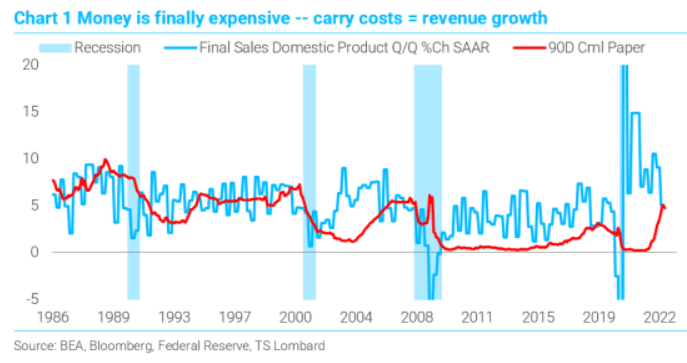Getting the Dollar Weaker will "Become an Unspoken Objective" for the Fed says TS Lombard
- Written by: Gary Howes
-
"Getting the dollar weaker will become an unspoken objective – the trade deficit is much too big given government policy aimed at reshoring production" - TS Lombard.

Image © Adobe Images
January's Federal Reserve interest rate hike has "all the hallmarks of being the last," says Steven Blitz, Chief US Economist at TS Lombard, an independent investment research company.
In a note to clients Blitz says all the data now points to an impending U.S. recession and the Fed will be pleased with evidence that the cost of money is finally getting to where the Fed wants it, which will help strangle inflation.
But Blitz sees another reason why the Fed will be keen to soon end the rate hiking cycle: the perceived strength of the currency it issues.
"Getting the dollar weaker will become an unspoken objective – the trade deficit is much too big given government policy aimed at reshoring production," he says.
The Dollar - in real terms - last year rose to multi-decade highs amidst safe-haven demand and the Federal Reserve's rapid rate of interest rate increases that outpaced those at its peers.
By calling an end to the hiking cycle the Fed, therefore, removes a central pillar of Dollar strength.
"Recession and the inventory cycle will fix the deficit to an extent, but it is the wide policy spread between the US and its major trading partners that needs to narrow – and the turn in US growth will negatively impact the global economy," says Blitz.
The 'policy spread' refers to the differential in interest rates that has been a key driver of Dollar strength. By allowing other central banks to close the interest rate gap, the Dollar's attractiveness wanes and it loses value.
This in turn could help improve the U.S. deficit, as noted by Blitz.
The Fed now has the cover of a slowing economy to end its hiking cycle. GDP still grew in the final quarter of 2022, according to the latest official data, but Blitz says a mild recession beginning in Q2 appears on track.
"Cuts arrive once employment turns negative, or even just softens to 100,000/month," he adds, suggesting market expectations for a rate cut from the Fed before year-end is on target.
Blitz finds the most important takeaway from fourth quarter GDP data is that 'short rates' are finally above inflation and nominal growth for final sales of domestic product.
"'Tight' is a matter of opinion, but monetary policy is no longer 'easy' and now getting 'tighter' - growth and inflation decelerated through the quarter," he says.
One argument against the Fed ending its rate hiking cycle soon is evidence that U.S. financial conditions have been getting 'easier', i.e. the cost of money has been falling of late.
This would appear to defy the Fed's intentions of making money more expensive to bring inflation back down.
"The recent easing of financial conditions is clearly an argument for further rate hikes," says Knut A. Magnussen, an economist at DNB Markets.
Above: U.S. financial conditions index show an easing in the cost of money, which might not be consistent with the Fed's aims when targetting lower inflation.
In line with a need to keep funding conditions restrictive, Magnussen says that guidance is likely to indicate further interest rate hikes are likely as the following key paragraph will be repeated:
But Blitz finds money is finally expensive as the spread between quarter-on-quarter growth in final sales of production (revenue proxy) and 90D commercial paper rates (cost of carry for inventory) "is now essentially zero and very likely flips negative in the current quarter".
"In the cycles beginning 2002, the Fed kept money too cheap too long, ramped up rates late in the cycle, and recessions arrived after this spread turned negative – which should happen in the current quarter," says Blitz.
"Next week’s 25 BP hike has all the earmarks of being the last hike," he adds.
Analysts are closely aligned on expecting a 25bp hike but there is a divergence in opinion about the nature of the guidance that will be forthcoming regarding the prospect of further hikes.
The Bank of Canada last week raised interest rates again but clearly stated it would now pause the hiking cycle, prompting a financial market reaction that would suggest investors see this as a harbinger for Fed guidance.







